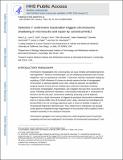| dc.contributor.author | Ly, Peter | |
| dc.contributor.author | Kim, Dong H. | |
| dc.contributor.author | Shoshani, Ofer | |
| dc.contributor.author | Skaletsky, Helen | |
| dc.contributor.author | Fachinetti, Daniele | |
| dc.contributor.author | Cleveland, Don W. | |
| dc.contributor.author | Teitz, Levi Shmuel | |
| dc.contributor.author | Page, David C | |
| dc.date.accessioned | 2018-07-05T18:11:05Z | |
| dc.date.available | 2018-07-05T18:11:05Z | |
| dc.date.issued | 2016-12 | |
| dc.date.submitted | 2016-04 | |
| dc.identifier.issn | 1465-7392 | |
| dc.identifier.issn | 1476-4679 | |
| dc.identifier.uri | http://hdl.handle.net/1721.1/116801 | |
| dc.description.abstract | Chromosome missegregation into a micronucleus can cause complex and localized genomic rearrangements known as chromothripsis, but the underlying mechanisms remain unresolved. Here we developed an inducible Y centromere-selective inactivation strategy by exploiting a CENP-A/histone H3 chimaera to directly examine the fate of missegregated chromosomes in otherwise diploid human cells. Using this approach, we identified a temporal cascade of events that are initiated following centromere inactivation involving chromosome missegregation, fragmentation, and re-ligation that span three consecutive cell cycles. Following centromere inactivation, a micronucleus harbouring the Y chromosome is formed in the first cell cycle. Chromosome shattering, producing up to 53 dispersed fragments from a single chromosome, is triggered by premature micronuclear condensation prior to or during mitotic entry of the second cycle. Lastly, canonical non-homologous end joining (NHEJ), but not homology-dependent repair, is shown to facilitate re-ligation of chromosomal fragments in the third cycle. Thus, initial errors in cell division can provoke further genomic instability through fragmentation of micronuclear DNAs coupled to NHEJ-mediated reassembly in the subsequent interphase. | en_US |
| dc.description.sponsorship | National Institutes of Health (U.S.) (Grant HG007852) | en_US |
| dc.publisher | Springer Nature | en_US |
| dc.relation.isversionof | http://dx.doi.org/10.1038/NCB3450 | en_US |
| dc.rights | Article is made available in accordance with the publisher's policy and may be subject to US copyright law. Please refer to the publisher's site for terms of use. | en_US |
| dc.source | PMC | en_US |
| dc.title | Selective Y centromere inactivation triggers chromosome shattering in micronuclei and repair by non-homologous end joining | en_US |
| dc.type | Article | en_US |
| dc.identifier.citation | Ly, Peter et al. “Selective Y Centromere Inactivation Triggers Chromosome Shattering in Micronuclei and Repair by Non-Homologous End Joining.” Nature Cell Biology 19, 1 (December 2016): 68–75 | en_US |
| dc.contributor.department | Massachusetts Institute of Technology. Department of Biology | en_US |
| dc.contributor.mitauthor | Teitz, Levi Shmuel | |
| dc.contributor.mitauthor | Page, David C | |
| dc.relation.journal | Nature Cell Biology | en_US |
| dc.eprint.version | Author's final manuscript | en_US |
| dc.type.uri | http://purl.org/eprint/type/JournalArticle | en_US |
| eprint.status | http://purl.org/eprint/status/PeerReviewed | en_US |
| dc.date.updated | 2018-07-02T14:18:44Z | |
| dspace.orderedauthors | Ly, Peter; Teitz, Levi S.; Kim, Dong H.; Shoshani, Ofer; Skaletsky, Helen; Fachinetti, Daniele; Page, David C.; Cleveland, Don W. | en_US |
| dspace.embargo.terms | N | en_US |
| dc.identifier.orcid | https://orcid.org/0000-0003-1783-2930 | |
| dc.identifier.orcid | https://orcid.org/0000-0001-9920-3411 | |
| mit.license | PUBLISHER_POLICY | en_US |
